Chapter 2 - Chicken Consumption
Chapter 2 - Chicken Consumption
Chicken meat is a popular food item in most countries and continues to increase in its popularity worldwide. Chicken is a relatively inexpensive, nutritious food source (see Table 2.1). The versatility of chicken has allowed for the introduction of a wide variety of further-processed products that meet the needs of the changing American lifestyle. No commercial meat is produced with higher feed efficiency, and at a faster rate, than that of chicken (see Table 2.2).
Table 2.1 - Nutritional information per 3-ounce boneless, cooked portion
| FOOD ITEM | Calories | Total fat (g) | Saturated fat (g) | Cholesterol (mg) | Protein (g) |
|---|---|---|---|---|---|
| Filet of sole, baked | 100 | 1.5 | 0.5 | 60 | 20 |
| Chicken breast, no skin, baked | 120 | 1.5 | 0.5 | 70 | 24 |
| Chicken drumstick, no skin, baked | 130 | 4.0 | 1.0 | 80 | 23 |
| Salmon, baked | 150 | 6 | 1.5 | 70 | 23 |
| Chicken breast with skin, baked | 160 | 7.0 | 1.0 | 6 | 22 |
| Beef sirloin steak, trimmed of visible fat, broiled | 170 | 7.0 | 2.0 | 70 | 25 |
| Chicken drumstick, with skin, baked | 180 | 9.0 | 3.0 | 75 | 25 |
| Chicken drumstick, with skin, baked | 10 | 9.0 | 3.0 | 75 | 23 |
| Pork loin rib chop, trimmed of visible fat, lean only | 180 | 9.0 | 3.0 | 60 | 24 |
| Canned cured ham, 13% fat, roasted | 190 | 13.0 | 4.0 | 55 | 17 |
| Lamp chop, trimmed of visible fat, broiled | 200 | 12.0 | 6.0 | 70 | 22 |
| Beef tenderloin, trimmed of visible fat, broiled | 200 | 11 | 4 | 72 | 23 |
| Beef, ground, extra lean, broiled, well done | 225 | 13.0 | 5.0 | 85 | 23 |
Source: Nutri-Facts Fresh food Labelling Program, 1995 and USDA Nutrient Database for Standard Reference, Release 14, 2001
Table 2.2 - Feed conversion efficiencies of major food animals
| Chicken | Pork | Beef | Carp | |
|---|---|---|---|---|
| Feed conversion (feed/live weight) | 2.5 | 5.0 | 10.0 | 1.5 |
| Feed conversion (feed/edible weight) | 4.5 | 9.4 | 25.0 | 2.3 |
| Protein content (% of edible weight) | 20 | 14 | 15 | 18 |
| Protein conversion efficiency (5%) | 20 | 10 | 4 | 30 |
Source: V. Smil, 2008. Eating meat: Evolution, Patterns and Consequences
TIDBIT: Where did the term 'broiler' come from?
The term 'broiler' comes from the main method that was used at that time for cooking chicken. Additional terms that came into use, such as 'fryer' and 'roaster,' also reflect the most common method used to cook a chicken of the specific market weight.
In breeding programs over the last several decades broilers have been selected for increased meat yield, high growth rate, and better feed conversion and high growth rates for many decades.
As shown in Figure 2.1, the average time required to raise a broiler chick to market was cut from 72 days in 1960 to 48 days in 1995. Over the same time period average slaughter weight rose from 4.0 to 4.8 lb and the feed/gain rate fell by 15%.

Genetics and nutritional improvements in broiler production have been extremely important to the efficiency of poultry meat production; however, the full genetic potential of broilers cannot be reached unless the proper environment is maintained in the broiler house. The fast growing, modern broiler lines are more dependent on proper environmental conditions than birds from lines raised just a few years ago.

The development of chickens specific for meat production has an interesting history. In the early 1900s the same chicken breeds were used for both meat and egg production, with little or no genetic selection. This all changed with the introduction of the ‘Chicken of tomorrow’ contests (see Figure 2.2). which were created to encourage the breeding of chickens for superior meat production. The result was the development of a faster, more efficient ‘broiler’ chicken. As the economy recovered from WW II, the demand of chicken increased and the industry was now prepared to supply it. There has been a constant increase in the per capita availability of chicken meat since around 1949.
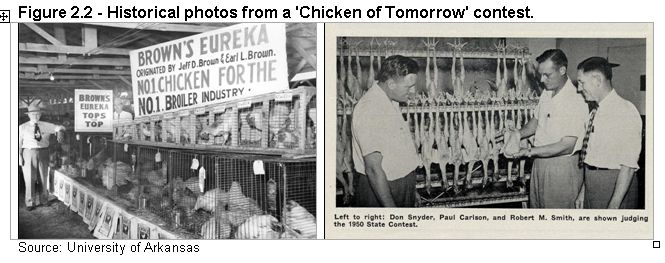
The broiler industry has become globalized – chicken meat is bought and sold around the world. Global poultry meat production in 2008 is projected to be 93 million metric tones (102.5 million tons), almost 4% higher than last year. The availability of a global market is one factor that has allowed the continuous increase in chicken meat production in the U.S.
A date of importance is 1986 when the Uruguay Round of the Global Agreement on Trade and Tariffs (GATT) began. Agriculture, which had previously been exempt, was included, opening export markets for U.S. chicken.
While there has been a steady increase in the pounds of chicken meat produced in the United States each year, the value of the product sold fluctuated dramatically (see Figure 2.3).
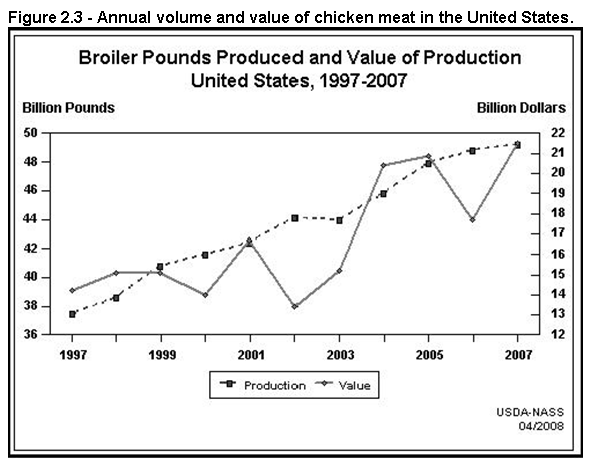
There were drops in the price of chicken in 2000, 2002, and 2004. Politics and disease are two main factors that affect the U.S.’s ability to export chicken, and thus the domestic price for chicken meat.
The U.S. is primarily a white-meat market (breast meat) leaving a lot of dark meat (leg quarters) to be sold. Russia, where the population has a preference for dark meat, is a major export market for American chicken. In 2002 the U.S.put a tariff on imported steel, and Russia, an exporter of steel to the U.S., retaliated by banning the importation of American poultry products.
Periodic outbreaks of low pathogenic Avian Influenza (LPAI) in the U.S. have resulted in temporary bans on chicken imports from the U.S. In both cases, the U.S. market became flooded with chicken meat, resulting in a drop in chicken prices. The prices for other meats also declined in order to compete with the cheaper chicken.
As shown in Figure 2.4. the majority of chicken meat production in the U.S. is in the southeast region. In 2007 Kentucky ranked 7th in broiler production. As with the nation as a whole, broiler production in Kentucky has been increasing annually (Figure 2.5).
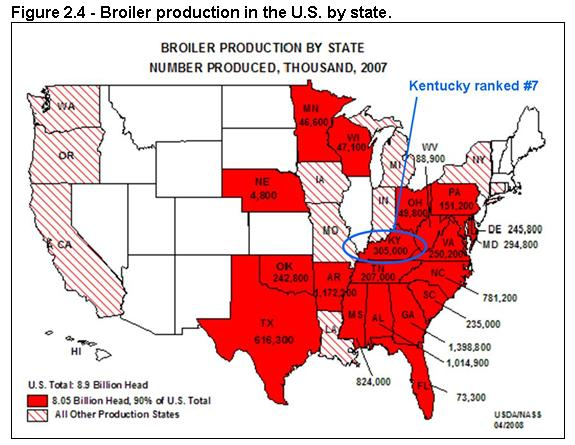
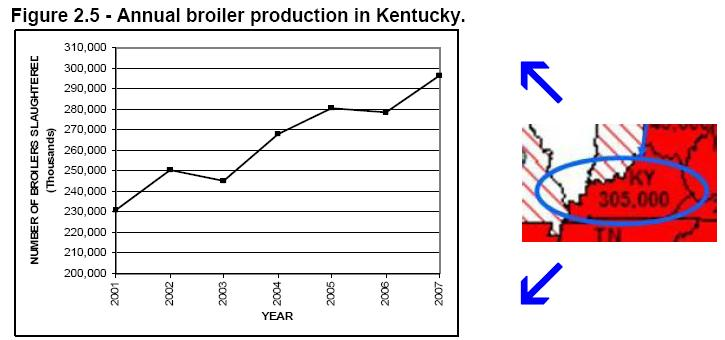
Americans currently consume about 81 pounds of chicken per person per year. Chicken production is expected to continue to increase to meet the demands of the growing human population. Estimations of the U.S. population are kept current by the Census Bureau by means of a 'Population clock'. The clock is periodically recalibrated based on the latest available data on births, deaths, and international migration. The American population estimate to September 25, 2009 at 3:30 PM Easternl Time was 307,543,378.
The component settings for September 2009:
- One birth every 7 seconds
- On death every 13 seconds
- One international migration (net) every 35 seconds
- Net gain of one person every 10 seconds
In the 2000 census, there were 281 million Americans counted. This was 54 million more than in 1980 and 7 million more than anticipated based on previous census estimates. Some of the deviation from estimated numbers may be due to improvements in census methodologies, but they clearly indicate that the U.S. is undergoing a population expansion. It is estimated that by 2020 another 50-80 million people will likely be added to the U.S. population, much of this from immigration which has been rising since the 1960s and shows no signs of reducing in the future.
The majority of Americans are between 25 and 54 years of age (Figure 2.6). The same is true for the Commonwealth of Kentucky (Figure 2.7).
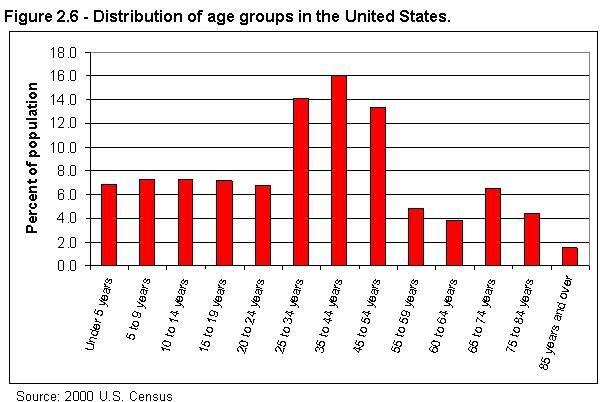
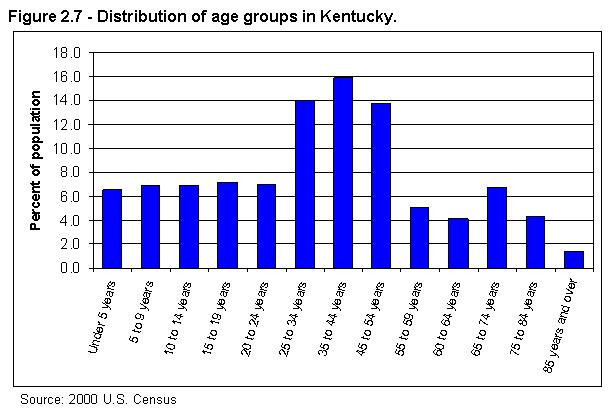
Education has made major progress in the U.S. over the last century as the percent of the population completing high school rose from 40 to 83. Similarly, the percent of the population graduating from college rose from 10 to 24. The result is that older, less-educated generations are being replaced by more-educated younger generations.
It has been predicted that by 2020, 86% of the U.S. population will have a high school degree and 26% will have finished college. This new, active American population wants meals that are easy and quick to prepare.
To meet the demand created by the changing American demographics and their associated life-style, the chicken meat industry has put considerable effort into the expansion of the value-added market. Chicken is a versatile meat that has been used in the creation of many ready-to-cook, or microwavable, meals.
